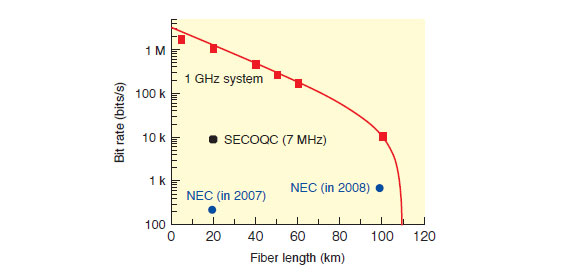- Back to the previous page
- Nano Materials & Devices
World-Record Quantum Key Distribution Bit Rate Realizing Ultra-Secure Networks
Dramatic improvement
in the performance and
utility of quantum key
distribution (QKD) will
realize next-generation
secure networks. Toshiba
has increased the secure bit rate 100-fold, achieving values
of 1.02 Mbits/s and 10.1 kbits/s over 20 km and 100 km
of optical fiber, respectively. These are world-record
values(*) and the first time that the bit rate has exceeded
1 Mbit/s under the unconditionally secure condition.
This advance stems from a recent invention by Toshiba
Research Europe Limited (TREL) in the field of single
photon detection technology. The self-differencing
avalanche photodiode allows a 100-fold increase in the
system clock rate and a 5 000-times higher maximum
count rate.
We also participated in a field trial of a small-scale
QKD network as part of the EU-funded SECOQC Project.
Operating QKD in real telecom networks, as opposed
to the private point-to-point links used previously, is
essential to broaden applicability and lower cost. The
TREL system (upper figure) operated stably and reliably
during the month-long deployment. Following the
successful conclusion of SECOQC, ETSI has launched a
standardization initiative for QKD.
The recent increase in bit rate will allow QKD to be
applied to much larger scale networks in the future.
Higher bit rates are important because the key material
must be shared between users in such networks. It will
also extend the range of individual links and allow highbandwidth
unconditionally secure communications using
a one-time pad.
(*) As of October 2008 (as researched by Toshiba)
SECOQC: Development of a Global Network for Secure Communication
based on Quantum Cryptography
ETSI: European Telecommunication Standards Institute

QKD system used in the EU field trial

Comparison of final key rates for unconditionally secure QKD


